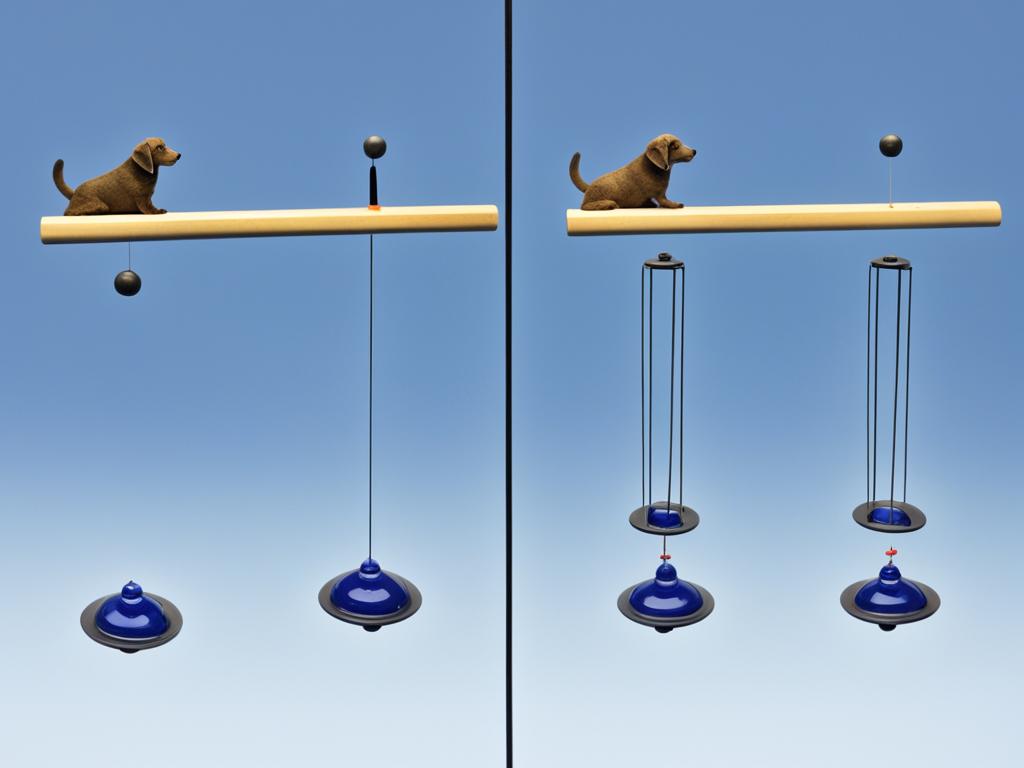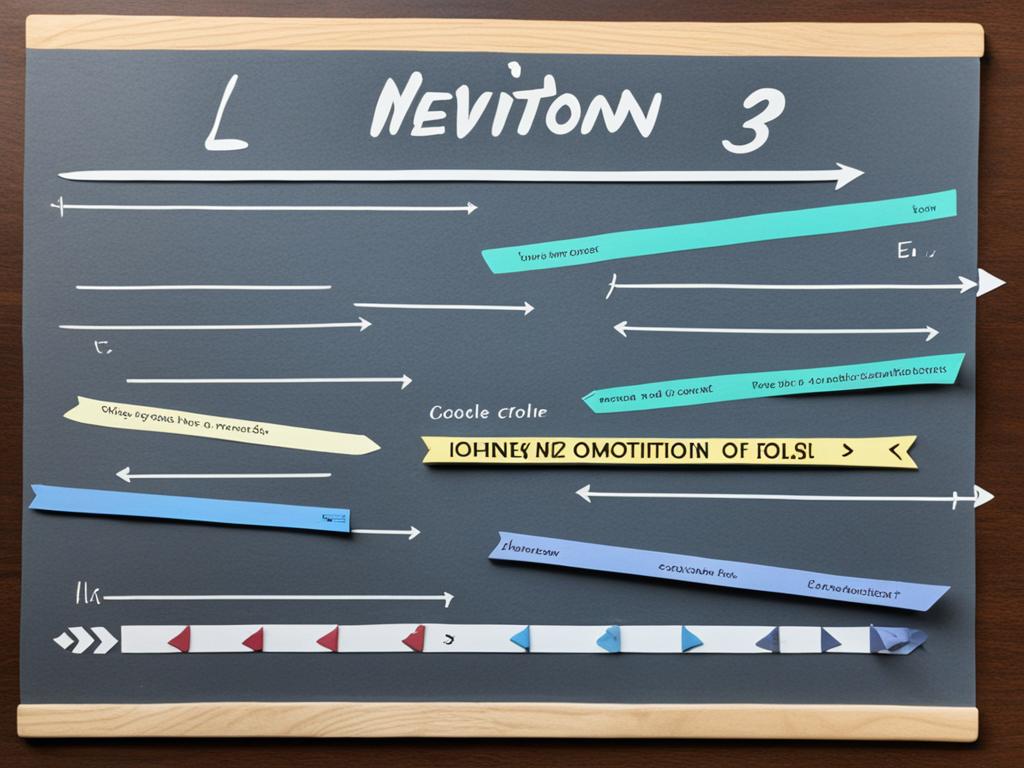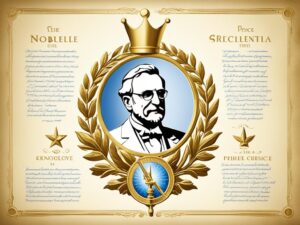
Newton’s Law of Motion: Fundamental Physics Explained
Newton’s Law of Motion is key to understanding the physical world. It explains how force, mass, and acceleration are connected. Sir Isaac Newton came up with these laws. They help us understand how objects move, from tiny particles to huge stars.

This article will explore Newton’s Law of Motion deeply. We’ll look at its importance, history, and the three main laws. These laws tell us how objects move in the universe. By learning these, we’ll see the forces at work in our daily lives and the universe.
What is Newton’s Law of Motion?
Newton’s Law of Motion is a key idea in physics. It shows how forces affect an object’s motion. Sir Isaac Newton came up with these laws. They help us understand the universe and are used in many sciences.
Significance and Relevance
These laws explain and predict how objects move. They work for tiny particles and huge stars. This makes them vital for many areas like engineering and sports.
Historical Background
In the 17th century, Sir Isaac Newton wrote “Philosophiæ Naturalis Principia Mathematica.” This book introduced three laws of motion. These laws changed how we see the universe.

“The fundamental laws of physics do not describe true facts about nature. They are nothing more than mathematical models we construct to try to explain what we observe.” – Richard Feynman
These laws are still key in physics today. They help us make new discoveries. Newton’s work has greatly influenced our understanding of the world.
The Three Laws of Motion
Sir Isaac Newton’s work on the laws of motion changed how we see the world. His three laws explain how forces affect an object’s motion. Let’s explore each law’s importance.
Newton’s First Law: The Law of Inertia
The first law says that things stay still or keep moving unless a force stops them. This is called inertia, the natural tendency to stay the same. It’s about how objects resist changes in their motion.
Newton’s Second Law: The Relationship Between Force, Mass, and Acceleration
The second law links force, mass, and acceleration. It shows that force times mass equals acceleration. This is written as F = ma, where F is force, m is mass, and a is acceleration.
Newton’s Third Law: Action and Reaction
The third law says every action has an equal opposite reaction. When one object pushes another, the second object pushes back just as hard. This idea helps us understand how things move and interact, from planets to everyday objects.
These laws help us predict how objects move and behave. They give us a deep look into the equilibrium and dynamics of our world.

| Law | Description | Equation |
|---|---|---|
| First Law | An object at rest will remain at rest, and an object in motion will continue to move at a constant velocity, unless acted upon by an unbalanced force. | – |
| Second Law | The acceleration of an object is directly proportional to the net force acting upon it and inversely proportional to its mass. | F = ma |
| Third Law | For every action, there is an equal and opposite reaction. | – |
“The foundation of all natural science is the mathematical sciences.” – Sir Isaac Newton
Newton’s Law of Motion: The First Law
Newton’s first law, also known as the Law of Inertia, is a key idea in physics. It tells us how objects act when they’re still or moving.
Inertia and its Effects
Inertia is when an object wants to keep doing what it’s doing unless something else stops it. So, if an object is still, it will stay still. If it’s moving, it will keep going the same speed and direction until something else makes it stop.
Many everyday things show us inertia at work. For instance, when a car stops suddenly, people inside keep moving forward because of inertia. Also, when a door opens quickly, the knob might swing back a bit before settling down.
Inertia is also key to understanding momentum, a big idea in newton’s law of motion. Momentum is how fast and heavy an object is moving. It shows how hard it is to change its motion.

Knowing about the first law of motion and inertia helps us understand how things move and work together. It’s vital for making things that follow the laws of physics.
The Second Law: Force and Acceleration
Newton’s Second Law of Motion is key to understanding how force, mass, and acceleration work together. It says that the speed an object speeds up is directly tied to the force on it and inversely tied to its mass.
The math behind this law is simple:
Force = Mass × Acceleration
Or, in a more detailed way:
F = m × a
This means that if you push harder on an object, it will speed up more, if its mass stays the same. But, if the object is heavier, it won’t speed up as much with the same force.
This law has big effects. It helps us figure out how things move, from tiny atoms to huge stars. By knowing how force, mass, and acceleration work together, we can make better machines, plan things out, and even learn about the universe.

“The acceleration of an object as produced by a net force is directly proportional to the magnitude of the net force, in the same direction as the net force, and inversely proportional to the mass of the object.” – Sir Isaac Newton
The Third Law: Action and Reaction
Newton’s Third Law of Motion is a key idea that helps us understand how objects interact. It says that for every force one object applies to another, the second object will apply an equal but opposite force back. This means that when you push on something, it will push back on you just as hard.
Practical Applications
This law is used in many areas, from simple daily actions to complex engineering and science. It’s important for understanding how objects stay balanced, how gravity and friction work, and its role in different fields.
- Equilibrium: The Third Law helps us see how objects in balance still feel forces. The forces one object puts on another are matched by an equal force in the opposite direction, keeping things stable.
- Gravity and Friction: The law also applies to forces like gravity and friction. For instance, when you put an object down, the surface pushes back with a force equal to the object’s weight.
- Engineering and Science: It’s key to understanding complex systems, like designing cars, analyzing sports movements, and studying space.
Understanding Newton’s Third Law lets us dive deep into how the physical world works. It shows us the intricate details from tiny interactions to huge cosmic events.
| Concept | Explanation | Example |
|---|---|---|
| Action and Reaction | For every action, there is an equal and opposite reaction. | When you push on a wall, the wall pushes back on you with an equal force. |
| Equilibrium | The net force on an object in equilibrium is zero. | A book resting on a table is in equilibrium, with the table exerting an upward force equal to the book’s weight. |
| Gravity and Friction | Gravitational and frictional forces are examples of action-reaction pairs. | When an object is placed on a surface, the surface exerts a normal force equal to the object’s weight. |
“For every action, there is an equal and opposite reaction.” – Sir Isaac Newton
Newton’s Third Law is a core idea that shapes how objects interact. By grasping this law and its uses, we can better understand the universe’s complex workings. It helps us see from tiny interactions to big cosmic events.
Newton’s Laws in the Real World
Newton’s Laws of Motion are not just for books. They shape the motion we see every day. From throwing a ball to how a car speeds up, these laws are everywhere.
Everyday Examples
Think about a simple bouncing ball. When you throw it up, it keeps moving until gravity and air slow it down. Then, it changes direction and speed, showing Newton’s Third Law at work. The bounce shows how force, mass, and speed are connected.
Car motion also shows these laws. When you press the gas, the engine pushes the wheels, making the car go faster. This follows Newton’s Second Law. When you hit the brakes, the car slows down, proving Newton’s Third Law again.
Even walking uses these laws. When you step, your muscles push against the ground. The ground pushes back, making you move forward. This back-and-forth force, as Newton’s Third Law explains, helps us move around easily.
FAQ
What is Newton’s Law of Motion?
Newton’s Law of Motion is a key idea in physics. It links force, mass, and acceleration together. Sir Isaac Newton came up with it. It has three main laws that explain how objects move.
What are the three laws of motion?
The three laws of motion are: 1. The Law of Inertia (First Law): An object stays still or keeps moving unless a force stops it. 2. The Law of Acceleration (Second Law): An object’s speed changes based on the force on it and its mass. 3. The Law of Action and Reaction (Third Law): Every action has an equal opposite reaction.
How does the First Law of Motion, the Law of Inertia, work?
The First Law says objects keep doing what they’re doing unless a force changes it. If an object is still, it stays still. If it moves, it keeps moving at the same speed. Forces can make it change its state.
What is the relationship between force, mass, and acceleration according to the Second Law of Motion?
The Second Law says an object’s speed change is based on the force on it and its mass. This is shown as F = ma, where F is force, m is mass, and a is speed change.
How does the Third Law of Motion, the Law of Action and Reaction, work?
The Third Law says every action has an equal opposite reaction. When one object pushes or pulls another, the second object does the same back. This helps us understand how objects move and interact.
How are Newton’s Laws of Motion applied in the real world?
Newton’s Laws are used in many ways, from simple things like a rolling ball to complex systems like spacecraft. They help us understand and design things like cars, see-saws, and more.



Newton law of motion is very important in the physical world.